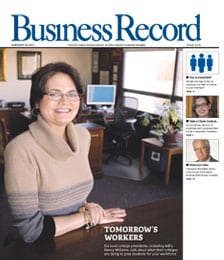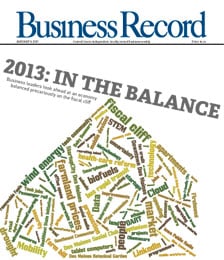That elephant in the room is Iowa’s ties to manufacturing

Earlier this month, Maytag Corp. Chairman and Chief Executive Ralph Hake delivered some somber thoughts on the future of Iowa’s manufacturing industry to members of the Des Moines Rotary Club. “It’s going to be really tough to grow that industry in this state,” he said, going on to explain that the strength of labor unions and the relatively high cost of making things in Iowa makes it difficult to rationalize bringing more manufacturing businesses here.
Those were powerful words, and there was a moment of silence among the crowd as the statement sunk in. Hake has told Wall Street that when it comes to the economy, his crystal ball isn’t any clearer than anyone else’s. He repeated the line again at the Rotary meeting, then let his statement fly.
Hake’s disclaimer aside, I would argue that there are few people in the state who are in a better position to read the manufacturing industry’s tea leaves. And I think he’s right.
Iowa exported $3 billion worth of manufactured items last year, ranking it 30th nationally. The bulk of the state’s products went to Canada, the United Kingdom and Mexico.
The state is home to 5,100 manufacturing companies, which generate more than 22 percent of the state’s gross state product, according to Iowa State University’s Center for Industrial Research and Service. That ranks Iowa ninth in terms of the importance of manufacturing to a state’s economy.
The manufacturing sector, in which roughly 12,000 fewer Iowans are working today than three years ago, is a big reason why Iowa’s unemployment figures have risen from 2.1 percent three years ago to 4 percent today.
On a national level, manufacturing is being eclipsed by more quickly growing sectors of the economy. It’s also losing jobs to countries that can build stuff more cheaply. From 1978 to 2000, the manufacturing portion of the country’s gross domestic product declined to 18 percent from 27 percent.
In Iowa, manufacturing is the biggest contributor to the state’s gross product. The sector is the third-largest employer in Iowa, behind services and trade-related jobs. Basically, Iowa has very large exposure to an industry that, nationally, is growing less important.
Gov. Tom Vilsack has fingered manufacturing, or I should say advanced manufacturing, as one of the four areas the state ought to focus on for the future.
I am not sure exactly what Vilsack means by advanced manufacturing, but I think it’s a risky strategy. I’ve seen plants that build rocking chairs and I’ve toured one of Intel Corp.’s newest semiconductor plants. The speed at which Silicon Valley’s companies are moving their manufacturing operations to Mexico, Eastern Europe and China will make your head spin.
Conversely, socks are still made in the U.S.A. Socks are so cheap there’s almost no benefit to producing them elsewhere. What does this mean? The more thought and money that goes into a product, the greater the incentive to ship production to places where it can be built more cheaply.
Some of America’s smartest “advanced” companies, such as San Diego’s Qualcomm Inc., don’t make anything at all. They think of cool stuff, figure out how to build it, and then ship the designs to a Third World country.
That Ericsson cell phone you’ve got? It was built by a Singapore-based company called Flextronics International Ltd., probably in Mexico or the Czech Republic.
We ought to be thinking about these trends as Iowa considers tying its cart to a horse that isn’t moving as fast as the rest of the country’s economy.
Hake knows all about these trends. That’s why he had to make the decision to shutter that plant in Galesburg, Ill. Some jobs will move from there to the newer Amana, Iowa plant. That’s good for Iowa, but I can’t help but think it’s a short-term gain. Maytag is also moving production to Mexico.
As sad as it is for those workers in Galesburg, this is progress. It pushes us to be better than we are – to constantly improve. Knowing this, it would be far better to spend our money on intellectual capital. It’s more flexible, travels well and its growth is unlimited.
In this regard, Pioneer Hi-Bred International Inc. is a great example. The company employs hundreds of super-smart researchers who develop products for the rest of the world.
When it comes to manufacturing, we ought to be looking elsewhere for new opportunities.







